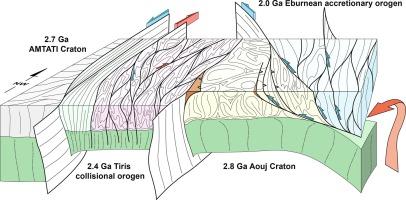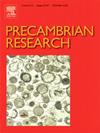西非克拉通雷圭巴特地盾的始新世克拉通组装和古近纪吸积-碰撞构造作用
IF 3.2
2区 地球科学
Q2 GEOSCIENCES, MULTIDISCIPLINARY
引用次数: 0
摘要
通过整合当前的地质年代知识对雷吉巴特地盾西部的变形模式进行解释,可以破译奥塞尔德陨石坑的组装和组装后的构造历史,该陨石坑被卷入巨大的埃伯恩(∼2 Ga)增生造山运动。最后的陨石坑组装是沿着新确认的西德早期(2.51-2.46 Ga)蒂里斯造山带进行的。在2.07-2.03 Ga之前,克拉通东缘一直受到西倾(即向克拉通方向)推力系统的影响,该推力系统植根于与埃伯恩造山带的碰撞接触中。碰撞是由热侵蚀和增生造山带对克拉通边缘的软化所控制的,这使得推力系统在克拉通岩石圈地幔向外分层的过程中得以传播。这就导致了阿尔奇安地壳逐渐融入增生造山带。这种热碰撞模式提供了一种机制,通过将其地壳重新加工成其侧翼的增生造山带,并将其岩石圈地幔回收到星体层,从而摧毁了板块。热碰撞模式有利于形成由岩石圈地幔分层驱动的特定岩石圈。本文章由计算机程序翻译,如有差异,请以英文原文为准。

Archean craton assembly and Paleoproterozoic accretion-collision tectonics in the Reguibat Shield, West African Craton
Interpretation of the deformation pattern of the western Reguibat Shield by integrating current geochronological knowledge allows deciphering the assembly and post-assembly tectonic history of the Awsard craton that became involved in the giant Eburnean (∼2 Ga) accretionary orogen. Final craton assembly took place along the newly recognized early Siderian (2.51–2.46 Ga) Tiris orogen. The eastern margin of the craton was then affected until 2.07–2.03 Ga by a west-verging (i.e., craton-ward) thrust system rooted in the collisional contact with the Eburnean orogen. Collision was controlled by thermal erosion and softening of the craton edge by the accretionary orogen, which allowed for the propagation of the thrust system during craton-ward progression of delamination of the cratonic lithospheric mantle. This resulted in the progressive incorporation of Archean crust into the accretionary orogen. Such a hot mode of collision provides a mechanism for the destruction of cratons by reworking of their crust into their flanking accretionary orogens and recycling of their lithospheric mantle into the asthenosphere. The hot collision mode favors the formation of specific oroclines driven by lithospheric mantle delamination.
求助全文
通过发布文献求助,成功后即可免费获取论文全文。
去求助
来源期刊

Precambrian Research
地学-地球科学综合
CiteScore
7.20
自引率
28.90%
发文量
325
审稿时长
12 months
期刊介绍:
Precambrian Research publishes studies on all aspects of the early stages of the composition, structure and evolution of the Earth and its planetary neighbours. With a focus on process-oriented and comparative studies, it covers, but is not restricted to, subjects such as:
(1) Chemical, biological, biochemical and cosmochemical evolution; the origin of life; the evolution of the oceans and atmosphere; the early fossil record; palaeobiology;
(2) Geochronology and isotope and elemental geochemistry;
(3) Precambrian mineral deposits;
(4) Geophysical aspects of the early Earth and Precambrian terrains;
(5) Nature, formation and evolution of the Precambrian lithosphere and mantle including magmatic, depositional, metamorphic and tectonic processes.
In addition, the editors particularly welcome integrated process-oriented studies that involve a combination of the above fields and comparative studies that demonstrate the effect of Precambrian evolution on Phanerozoic earth system processes.
Regional and localised studies of Precambrian phenomena are considered appropriate only when the detail and quality allow illustration of a wider process, or when significant gaps in basic knowledge of a particular area can be filled.
 求助内容:
求助内容: 应助结果提醒方式:
应助结果提醒方式:


